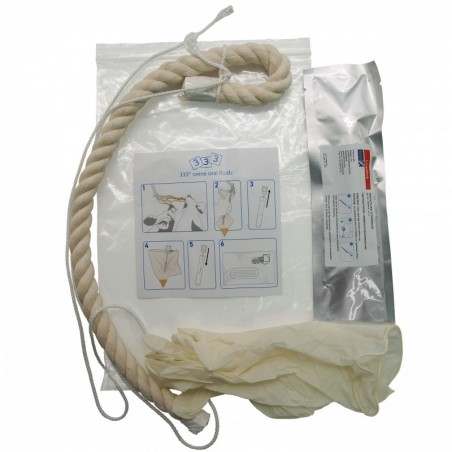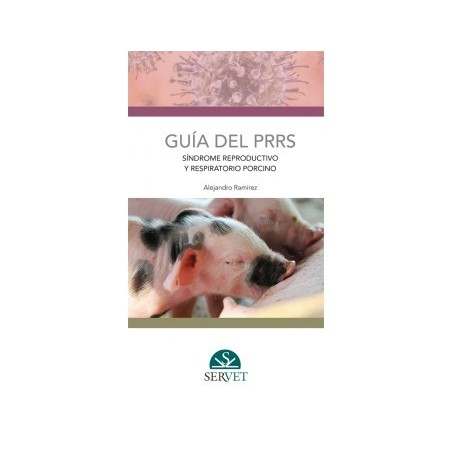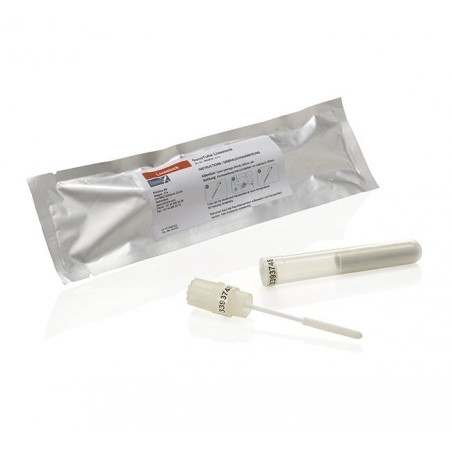Assays available
Gross pathology
- Identification of lesions especially vesicles in snout and feet areas
- Pros:
- Easy to identify vesicles grossly
- Cons:
- Clinically indistinguishable from all other vesicular diseases
- Usually require other diagnostic confirmation


- Detects presence of specific sequence of viral nucleic acid (RNA)
- Sample types: vesicular fluid or epithelium (preferred sample type), serum, esophageal-pharyngeal sample (when vesicle or epithelium not available), milk
- Pros:
- Most sensitive and preferred method for detecting agent
- Can often do pooling of samples to lower cost while minimizing loss of sensitivity
- Can target universal proteins for general detection or serotype specific proteins for serotyping
- Cons:
- Moderate cost
- Requires proper primers especially if targeting structural proteins which are serotype specific
List of currently known serotypes for FMD (There is no cross protection between serotypes):
- Asia 1
- South African Type 1 (SAT 3)
- South African Type 1 (SAT 2)
- South African Type 1 (SAT 1)
- C
- A
- O
Antigen Enzyme-linked immunosorbent assay (Ag-ELISA)
- Detects presence of antigen
- Sample types: vesicular fluid or epithelium (preferred sample type), serum, esophageal-pharyngeal sample (when vesicle or epithelium not available), milk
- Pros:
- Preferred method for detection and identification of serotype
- Can be used at an individual animal or herd level diagnosis
- Can be used to differentiate serotypes
- Any positive result to wild-type virus is considered significant
Table 1. Different viral proteins can be used to help with diagnostic goals.
| Target antigen | Variability | Use |
|---|---|---|
| Structural proteins | Variable | Serotyping |
| Non-structural proteins | Conserved | Universal detection: None-Serotype specific |
- Cons:
- Presence of viral antigen may be serotype specific
- May need to do multiple tests to identify serotypes
Antibody Enzyme-linked immunosorbent assay (Ab-ELISA)
- Detects presence of antibodies
- Sample types: serum
- Pros:
- Circulating antibodies can be detected as soon as 3-5 days after clinical signs noted
- Animals remain positive for several months
- Can be used in older cases
- Can be used to differentiate exposure to wild-type from some killed/recombinant vaccines (target specific non-structural proteins)
- Any positive result to wild-type virus is considered significant
- Cons:
- Antibody response is serotype specific
- Some animals may stay seropositive for several years
- Strength of immune response may vary with virulence of strain
- Presence of antibodies does not always correlate with protection
Lateral flow devices (LFD)
- Detects presence of antigen
- Sample types: vesicular fluid or epithelium
- Pros:
- Preferred method for detection and identification of serotype
- Can be used at an individual animal or herd level diagnosis
- Can be used to differentiate serotypes
- Any positive result to wild-type virus is considered significant
- Cons:
- Presence of viral antigen may be serotype specific
- Less sensitive than Ag-ELISA
- May need to do multiple tests to identify serotypes
Virus isolation (VI)
- Isolates live virus
- Sample types: vesicular fluid or epithelium (preferred sample type), serum, esophageal-pharyngeal sample (when vesicle or epithelium not available), milk
- Pros:
- Traditional gold standard
- Isolate virus for use in vaccine development (autogenous vaccines) or serology testing (ELISA) to determine serotype.
- Expensive
- Slow results
- Requires special cell lines; bovine (calf) thyroid cells or pig, calf, or lamb kidney cells
- Inoculation process is labor intensive
- Often difficult to grow (false negatives)
Genetic sequencing
- Sequences virus’s genetic nucleic acids (RNA)
- Sample types: vesicular fluid or epithelium (preferred sample type), serum, esophageal-pharyngeal sample (when vesicle or epithelium not available), milk
- Pros:
- Can help with molecular epidemiology
- Help identify serotype
- Cons:
- Expensive
- Slow to get results
Result interpretation
Gross Lesions (vesicles)
- Positive: Must investigate as possible FMD
- Negative: Negative or missed if testing occurs late after infection or infected with a mild strain
PCR
- Positive: Virus is present
- Negative: Negative or virus could have been missed if testing occurs late after infection
Ag-ELISA
- Positive: Virus is present
- Negative: Negative, virus could have been missed if testing occurs late after infection, or tested for wrong serotype
Ab-ELISA
- Positive: Maternal antibodies or past exposure (>2-3 days) to wild-type virus or some vaccines
- Negative: Negative or exposure to vaccine or wild-type virus too early to detect, or tested for wrong serotype antibody
LFD
- Positive: Virus is present
- Negative: Negative, virus could have been missed if testing occurs late after infection, or tested for wrong serotype
VI

- Positive: Virus is present
- Negative: Negative, virus could have been missed if testing occurs late after infection, or wrong cell line used
Genetic Sequencing
- Positive: Virus is present
- Negative: Negative, virus could have been missed if testing occurs late after infection, or too little virus present for sequencing
Scenarios
It is important to note that some countries may require approval by federal authorities before any testing for FMD can be done.
Suspected acute FMD outbreak in any age pigs and herd not vaccinated for FMD
- Collect vesicular fluid from multiple affected animals and test via Ag-ELISA or PCR; for PCR sample pooling may be considered
Suspected acute FMD outbreak in any age pigs and herd vaccinated for FMD
- Collect vesicular fluid from multiple affected animals and test via Ag-ELISA or PCR; for PCR sample pooling may be considered
- Collect serum from multiple affected animals that have shown clinical signs for at least 3 days and test individually via Ab-ELISA; target non-structural protein that is not present in vaccine
Suspicion of FMD circulation in any age pigs with no clinical signs and herd is not vaccinated for FMD
- Collect serum from 30 randomly sampled pigs and test individually via Ab-ELISA; target structural protein
Suspicion of FMD circulation in any age pigs with no clinical signs and herd is vaccinated for FMD
- Collect serum from 30 randomly sampled pigs and test individually via Ab-ELISA; target none-structural protein that is not present in vaccine







